After years of building WordPress websites, we’ve learned how important it is to have a local WordPress setup on your computer.
Having WordPress on your personal machine lets you experiment with new features without risking your live site, dive deep into WordPress development, and even build entire websites before they go live. It’s like having a private sandbox for all your WordPress projects.
If you’re a Windows user, there are numerous ways to set up WordPress locally. But we’ve narrowed it down to the two easiest methods. In this guide, we will show you how to easily install WordPress on a Windows computer, no matter which version you’re using.
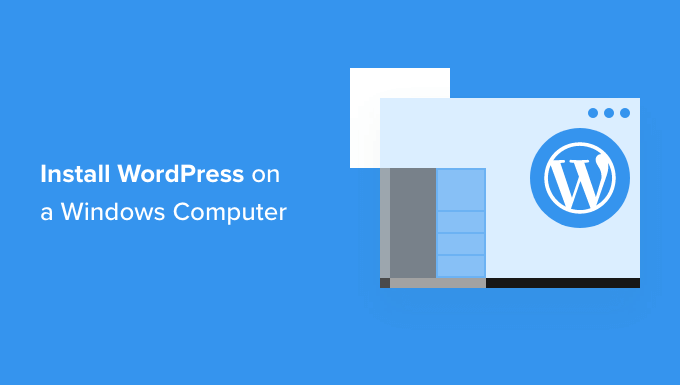
Why You Should Install WordPress on Windows?
If you’re a Windows user, then installing WordPress locally on your computer offers several benefits.
A local WordPress installation creates a testing environment that doesn’t affect your live website. This setup, often called a local server or localhost, is your personal playground for WordPress.
WordPress developers regularly use local installations for their work. For instance, they may use it to experiment with new plugins or themes or test the site before updating to the Gutenberg block editor.
But it’s not just for the pros. If you’re new to WordPress, a local setup is perfect for learning. You can explore features, test themes and plugins, and experiment freely without worrying about breaking a live site.
It’s important to note that when you install WordPress locally on Windows, only you can see the site. If you want to create a public website, then you’ll need a domain name and web hosting.
Now, technically, you can install WordPress on Windows using XAMPP, and we’ve written a tutorial on it before.
That being said, we’ve found 2 even simpler ways than XAMPP for setting up a local WordPress environment, making them great for beginners or users who need to create a local site quickly. You can click the link below to jump ahead to any method you’re interested in:
Method 1: Install WordPress on Windows Using Studio (Quick and Simple)
For the first method, we will use Studio. It’s a local WordPress software made by Automattic, the company that manages and runs WordPress.com, which is a website builder based on the WordPress software.
We will talk about this method first because it’s much quicker and simpler to follow, making it perfect for complete beginners.
First, you need to open the Studio by WordPress.com website. Then, click on the ‘Download for Windows’ button.
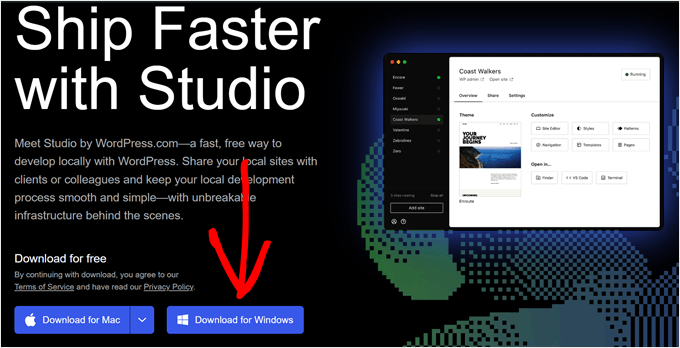
Once you’ve done that, just open the downloaded file to start the installation.
A popup window will now appear, showing you that the application is being installed.
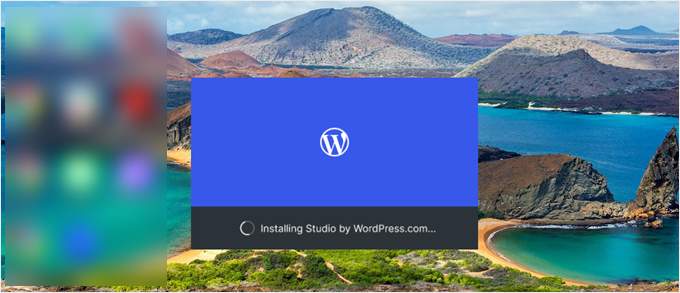
With that done, you can add your first site.
To do this, just enter your new local WordPress site name and click ‘Add site.’ You can name the site however you like so long as it helps you easily identify it.
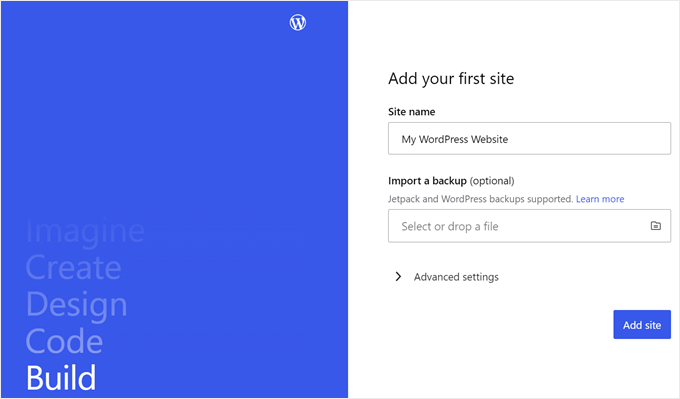
You should now see your local WordPress site dashboard.
To access your WordPress dashboard and edit your website, just click the ‘Start’ button at the top right corner. This will make your local website accessible to you on your computer.
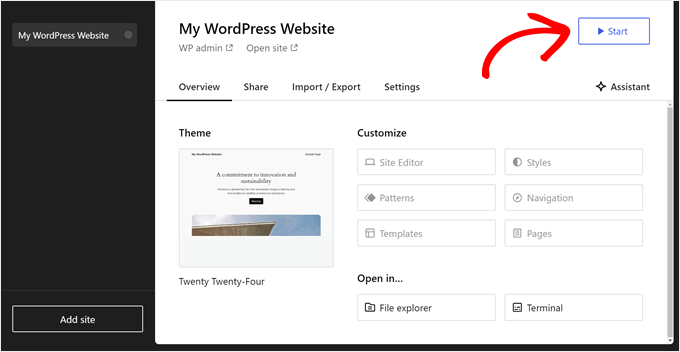
Once the ‘Start’ button changes to ‘Running,’ you can click on the ‘WP Admin’ link at the top left side of the page.
This will bring you to your local WordPress admin page.
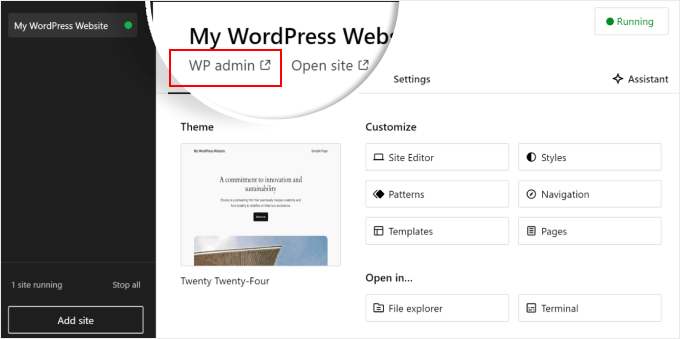
And that’s pretty much it for the setup. Let’s explore the other settings that may be necessary as you build your local website.
As you can see in the ‘Overview’ tab, you can immediately access the WordPress full-site editor menu right from the Studio dashboard. You can also click ‘File explorer’ to open your WordPress website’s folders and files and click on ‘Terminal’ to manage your website using WP-CLI.
If you switch to the ‘Share’ tab, you can log in to your WordPress.com account, clone your local website, and upload it to WordPress.com’s servers. This will temporarily make the cloned site online, which is useful for sharing demo sites with your clients or team members.
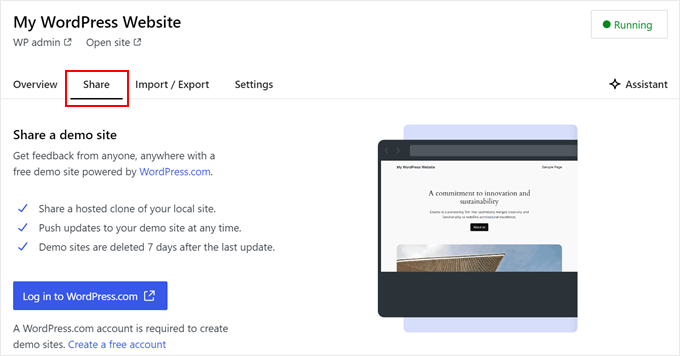
At times, you may want to log in to your local website directly through your browser instead of using Studio. In that case, you need to know your wp-admin credentials.
To find them, you can switch to the ‘Settings’ tab and find your WordPress admin username, password, and login URL there.
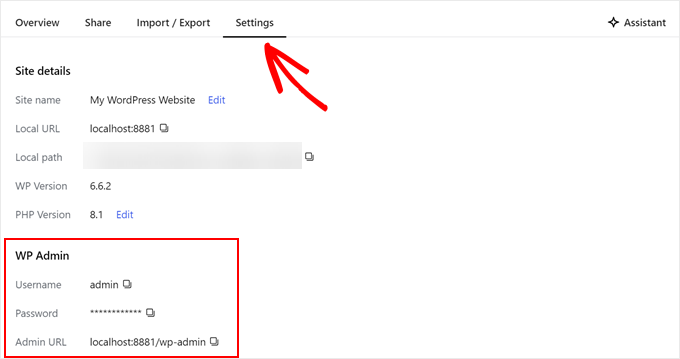
Another neat feature of Studio is its built-in AI chatbot, which you can communicate with by clicking on the ‘Assistant’ button.
Here, you can ask Studio for help with tasks like updating all your plugins at once, updating your core WordPress version, or creating code for a custom block.
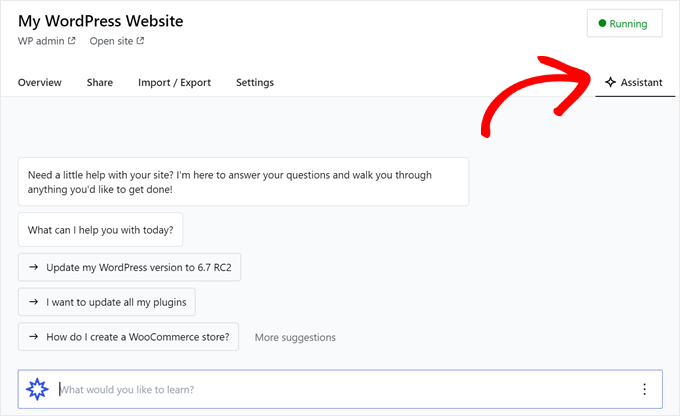
When you’re done working on your local site, just hover over the ‘Running’ button at the top right corner until it says ‘Stop.’
Then, click on the button to stop the website.
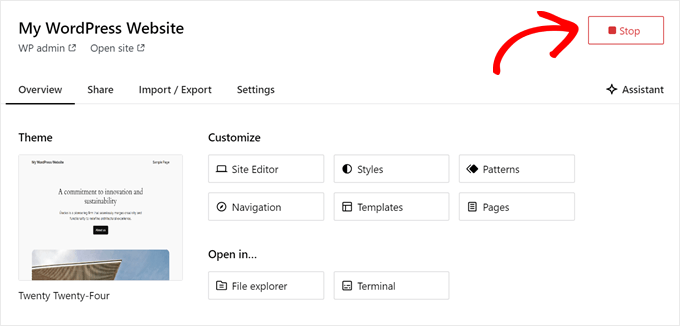
One downside of Studio is you cannot configure the WordPress environment to your liking. This means you need to use the PHP version, web server, and database that have been pre-selected for you.
This can be a drawback if you need to test your website or plugin with specific server configurations.
If you require more control over your local WordPress environment or need to match your local setup with a specific live server configuration, then you can check out the next method using Local WP.
Method 2: Install WordPress on Windows Using Local WP (More Customizable)
First, you need to download and install the Local WP software on your Windows computer. Simply go to the Local WP website and click the ‘Download for Free’ button.
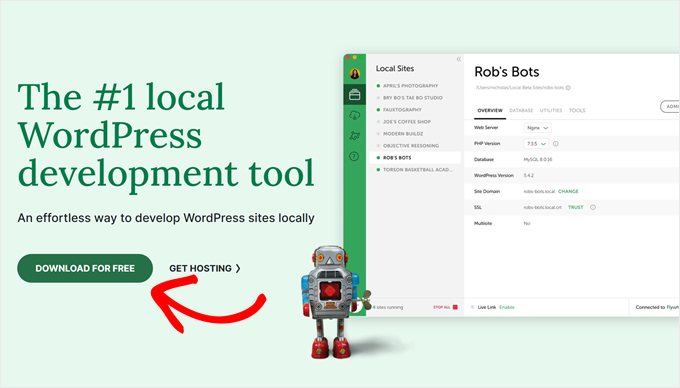
After that, a popup window will appear where you’ll need to select your platform. Go ahead and choose ‘Windows’ from the dropdown menu.
Next, you can enter your details like first and last name, work email address, and phone number to download the software.
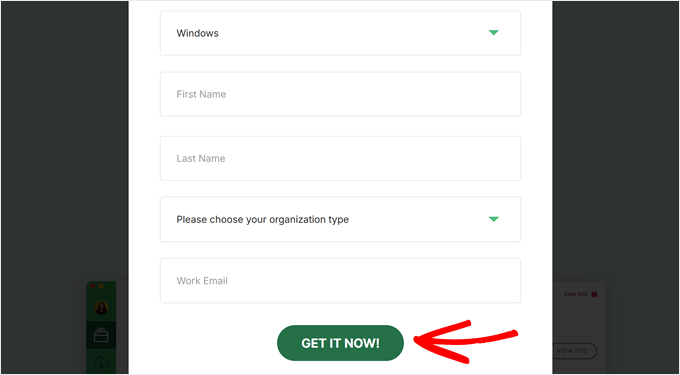
Upon entering the details, simply click the ‘Get it Now’ button.
After that, the software will be automatically downloaded into your computer. Otherwise, you can click on the ‘click here’ link to start the download.
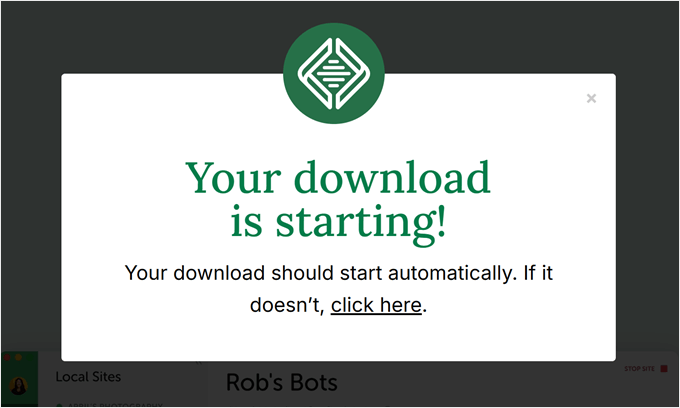
Once the file is downloaded, go ahead and launch the setup wizard.
Now, you’ll need to select whether you’d like to install the software for all users or only for you.
Once you’ve selected an option, click the ‘Next’ button.
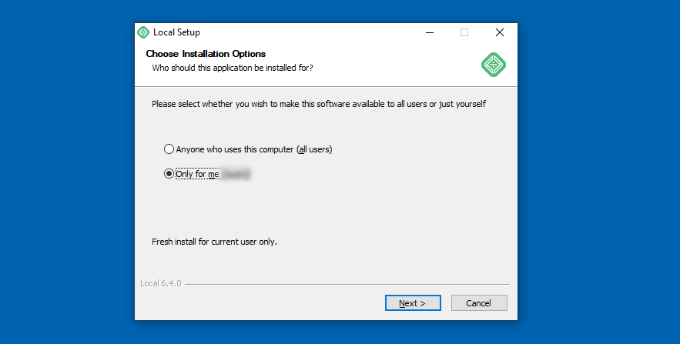
In the next step, you can select the ‘Destination Folder’ where the software will be installed.
Simply click the ‘Browse’ button to set the path and then click the ‘Install’ button.
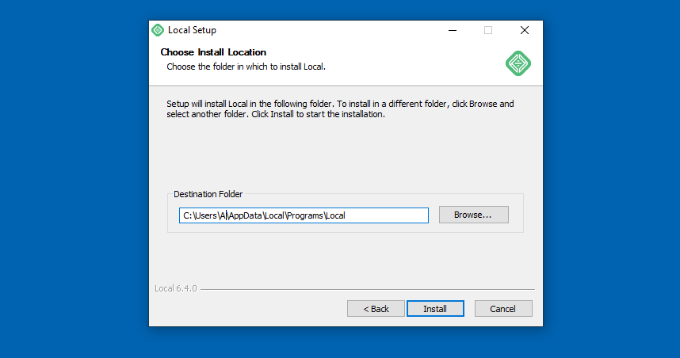
The Local WP software will now install on your Windows computer.
Once it’s done, you can check the ‘Run Local’ checkbox and click the ‘Finish’ button in the setup wizard.
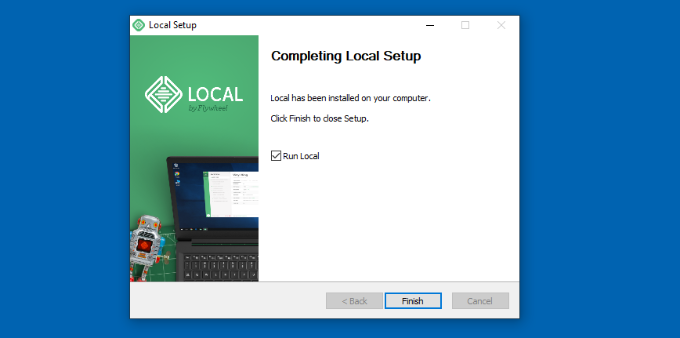
The software will now launch on your Windows device.
The next step is to add a new local website. To do that, simply click the plus ‘+’ button at the bottom.
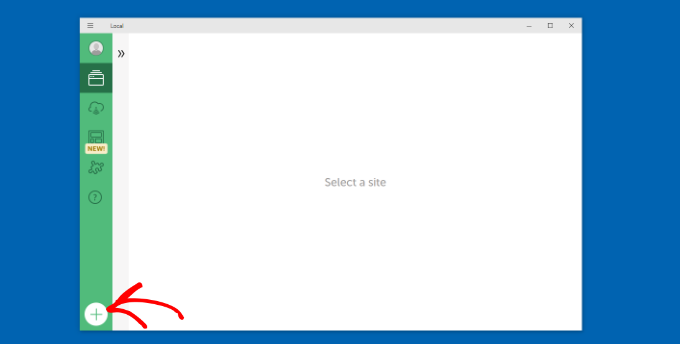
After that, you can create a site in the Local software.
Select the ‘Create a new site’ option and click the ‘Continue’ button. There are also options to create the site from a blueprint or an existing website file, but we’ll go with the first option for the sake of demonstration.
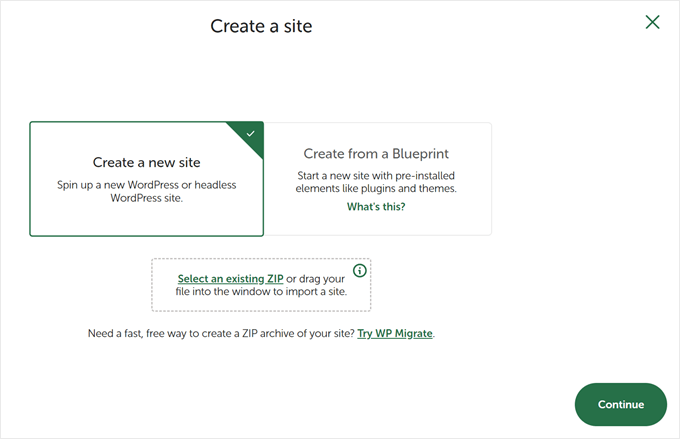
Next, you can enter a name for your local website, like ‘My WordPress Website.’
There are also advanced options where you can enter the local site domain and local site path. By default, the domain will use your website title but separated with dashes.
Once you’re done, simply click the ‘Continue’ button.
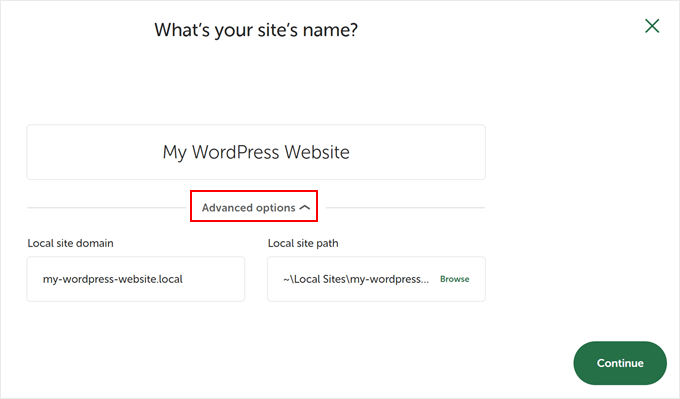
After that, you will need to choose an environment for your local website.
You can use the ‘Preferred’ environment where the software will automatically select the PHP version, web server, and MySQL version. On the other hand, you can also select ‘Custom’ and enter the environment details.
Local WP offers the latest PHP versions. As for the web server, you can choose between Nginx or Apache. You can also select between MySQL or MariaDB for the databases.
Do note that some PHP, web server, and database versions require downloading some dependencies for them to work properly.
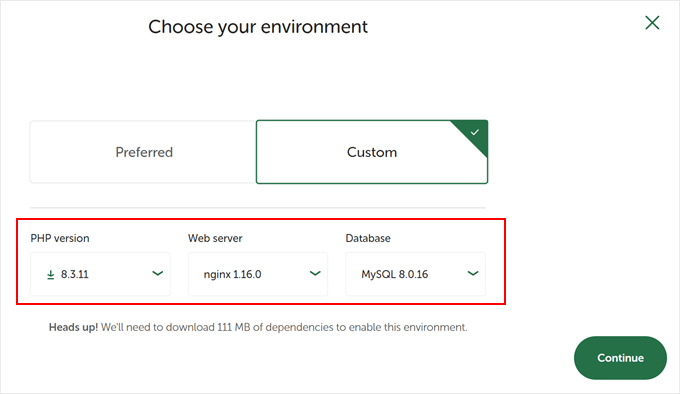
Next, you can enter a WordPress username and password for your local website. Plus, there’s also an option to choose a WordPress email address where you’ll receive all the email notifications.
Other than that, there is an advanced option where the software will ask whether you have a WordPress multisite network. If not, just click ‘No.’
After entering these details, simply click the ‘Add Site’ button.
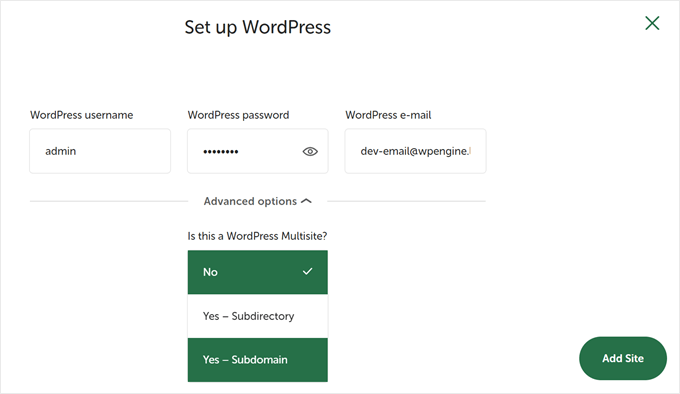
The software will now install WordPress and set up your website.
To launch the local website, go ahead and click on the ‘Start site’ button at the top right corner.
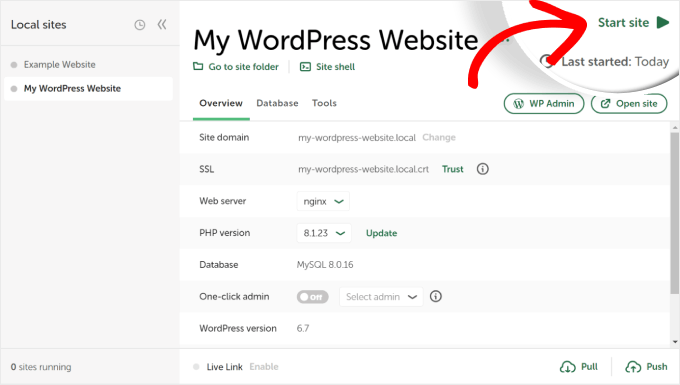
Next, click on the ‘WP Admin’ button, and you’ll see the WordPress admin login page.
Simply enter the username and password you entered earlier when setting up the local website, and then click the ‘Log In’ button.
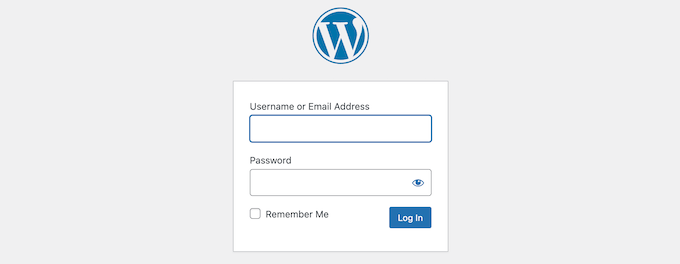
You can now edit your local website on your Windows computer.
When you’re done, don’t forget to stop the website from the Local WP software by clicking the ‘Stop site’ button.
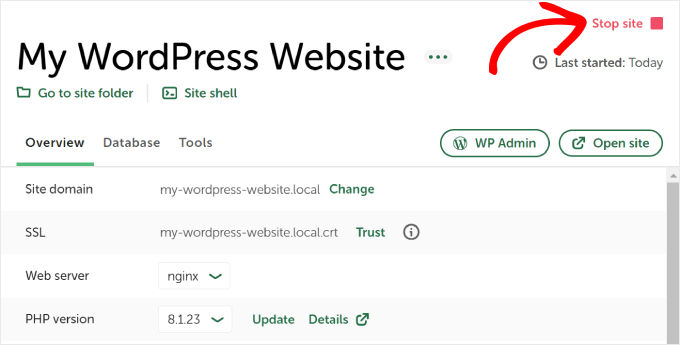
Pro Tip: If you want to skip the login process, you can enable a one-click admin login in Local WP.
To do this, just go back to the Local WP dashboard and toggle the ‘One-click admin’ button until it says ‘On.’ Then, in the dropdown menu, select the admin user that can use this one-click login feature.
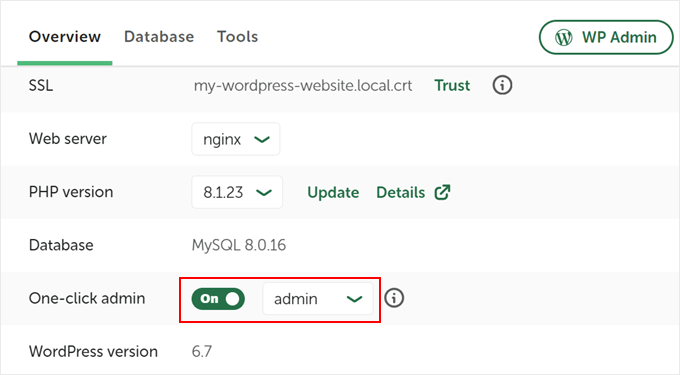
Alternative: Use WordPress Playground to Test Themes, Plugins, and More
WordPress Playground is an innovative tool that lets you experiment with WordPress directly in your web browser. It’s a virtual sandbox where you can try new WordPress themes, plugins, and features without affecting any real website.
WordPress Playground differs from a local WordPress environment in several key ways.
First, it doesn’t require installation on your computer and resets after each use, unlike permanent local setups. You can access it from any device with a browser, while local installations are tied to one computer.
While WordPress Playground is ideal for quick tests and learning, a local WordPress environment on your Windows computer offers more flexibility for long-term development projects.
For a detailed walkthrough, check out our guide on how to use WordPress Playground in your browser.
I’ve Installed WordPress on My Windows Computer, What Now?
Now that you have WordPress on your computer, here are some things you can do:
- Learn basic WordPress tips and tricks to use your site better.
- Try different WordPress themes to see how your site can look.
- Install and test must-have WordPress plugins to add new features to your site.
- Learn how to fix common WordPress errors on your own.
- Try different drag-and-drop page builders to make your site look nice.
- Learn how to reset the WordPress admin password on localhost to recover access to your site.
- Set up automated workflows to make managing your site easier.
- Learn about WordPress security to keep your site safe from hackers.
- Move your local WordPress site to a live server when you’re ready to share it with everyone.
We hope this article helped you learn how to install WordPress locally on a Windows computer. You may also want to see our article on how to install WordPress locally on a Mac computer and our ultimate guide to creating a WordPress staging site.
If you liked this article, then please subscribe to our YouTube Channel for WordPress video tutorials. You can also find us on Twitter and Facebook.





Ruchira
Excellent article. I could install successfully wordpress following this article.
Thank you.
Lindsay
I’m trying to set up a local copy of an existing site. I have a full backup of the site, I have a copy of the database, but when I create a new database in WAMP and try to import the database copy I have, it tells me the database already exists. If anyone can help me figure out what I’m doing wrong I would be very grateful.
Enric
It works perfect!
Christie
ok, got it to work, but trying to install a theme and it gives me error message: The uploaded file exceeds the upload_max_filesize directive in php.ini.
WPBeginner Support
Hi Christie,
Please see how to increase maximum upload size limit in WordPress.
Admin
Christie
I did everything step by step, when opening my local host, it gives me this error message “Error establishing a database connection”. What did I do incorrectly? Thanks!
Sammy P
Excellent tutorial! I am a developer, and totally new to WordPress. And with this tutorial, I was able to set up a complete WordPress test environment on my PC. Thank you!
Nicole
I can’t thank you enough for this help. It worked and walked me through the steps perfectly. Bravo! Cheers to your success in life.
Jacy Lucier
After installing WAMP, a short-cut icon appears on the desktop. It’s not green, and it doesn’t do anything. The real icon used to open WAMP is in the notification area on the task bar – usually at the far right and sometimes, depending on your setup, you must click the up ^ arrow to access it.
Tony
Very helpful article. I installed it and it is running perfect but I am facing an error whenever I Go to Theme/Plugins and click on Add New “An unexpected error occurred. Something may be wrong with WordPress.org or this server’s configuration. If you continue to have problems, please try the support forums.”
or when I go to Setting—>General I see this message on the page “Warning: An unexpected error occurred. Something may be wrong with WordPress.org or this server’s configuration. If you continue to have problems, please try the support forums. (WordPress could not establish a secure connection to WordPress.org. Please contact your server administrator.) in C:\wamp64\www\Ain-Ebel\wp-admin\includes\translation-install.php on line 66”
Can you please assist.
Thanks
Himani Bhardwaj
The only solution I’ve found is to get a better internet connection. Because This Error is so common when an internet speed is slow.
Kiki
Hello,
I get this error after selection a language:
“This program can only be installed on Versions of windows designed for the following processor architectures 64x”
But I tried the 32 en 64 bit version… Can you help?
Aniruddha Chaudhari
I am getting this error:
“The program can’t start because api-ms-win-crt-runtime-|1-1-0.dll is missing from your computer. Try reinstalling the program to fix this problem.”
Any suggestion?
nabil
try installing wamp server version 2.5.
Version 3.0 does not support in some older OS
Saradha
Such a good explanation. Great Work. Thanks!
ian
great info..what my question is…if I decide to make the website with my computer then upload to local site…will the DB still work the same or is code different now..cause I’m on their data base
WPBeginner Support
Hi Ian,
Once you are done with developing your site on your computer, you can move it to a live website.
Admin
Goki
Thank you,such precise explanation
Frank
Went through all of this and it worked fine. Had WAMP running and localhost site running. Was looking at themes. Closed everything down and restarted and now the MYSQL service won’t start. Apache starts and MariaDB starts but mysql won’t start. I’ve searched with google and tried a few solutions but can’t get the issue resolved. I’ve looked in MYSQL log and it’s blank. I’ve tried reinstalling the service and that doesn’t help.
Richard Grove
After renaming wordpress folder and pasting it to the wamp64 folder I get a file 404 error when trying to open browser/ Did I miss a step somewhere? Thanks
Cedric
Hi
Don’t paste the wordpress folder in the general ‘wamp64 folder’
BUT
paste it in the ‘www’ folder inside the ‘wamp64’ folder.
Shabana Anjum Khan
Simple and Easy , thank you
Kim
Great guide, worked like a charm!
vandana
Its really helpful for a novice like me . thanks a lot
ahmad sabry
many thanks it was easy and usefull
Solomon
What else can I say…? This is so informative, and timely. Last week I was struggling to get WordPress installed on my local machine; now it’s done. Good job guys!
Marilyn Mutsune
I really appreciate WP beginner. However, am not tech savvy thus a bit slow on grasping what is probably fundamental for most people.
Now, I got as far as installing Wampserver 64 but when I try http: localhost/my site I get Error 404.
What is the problem? I have done all I possibly can but the error message keeps coming on.
Please help.
Thanks in advance.
Timilz
Ensure there’s no spacing in between local host/mysite
Yogesh Malik
Thanks it is really help full and install the WordPress successfully from above steps.
Tom Martin-Wells
Thanks a bunch for this post, I had been struggling for a while to set up a local server so I could safely test and develop my site, but all the other guides I found never worked. Yours has finally got this sorted for me! Big love.
Marilyn Mutsune
Help! I have been successful to this point but now I can’t rename the folder. The prompt keeps reading, “a file or folder is open in another location.”
Further, I tried pasting http;//localhost/wamp64 in my browser, it gives the error 404. Also, I want to build my website locally before I go live. Please assist me.
Lastly, have mercy this web building stuff is super scary, I just want to write but I need to show case my portfolio. Thus, I have to do this.
Sunday akinola
Great job. Please can we have pdf version of these guides for downloads. Thanks ….
Jeff Collins
After I gave the database a name; it asks me to name a table. I’m not seeing anything like what is on this page after setting a database name.
Nathan Wakefield
Hi guys, I use tutorials all the time, but never felt the need to comment.
Great job! Simple, concise, no need to investigate further on other sites.
Love your work.
Nasredeen
thank you !
Really Helpful…..
Jim Felland
Thank you for the accurate tutorial, this was dead on and walked us right through. Thank you Thank you Thank you
David
Hi,
After coping the wordpress folder to the wamp www folder, I renamed the folder to mysite. When I try to open the url in the browser I get the error message Object not found.
Please advise.
Thanks
David
Carmelo
Please help me what to do after installing wampserver, I opened the phpMyAdmin but its a blank space. It’s not the “Welcome to phpMyAdmin as shown above where I can log in. What do I do. Please. Thanks
PW
Hi,
I want to know if I can share my locally developed site to a friend before pushing it live without having hosting.
amar
thanks for steps. it is really helpful me for installation.
ern
Just wanted to thank you a zillion times for this excellent tutorial, so detailed, i followed it and it went so smoothly!
Leo
I hit a roadblock. I loaded WP in the WAMP folder. Then when it comes to “Now open your web browser and go to localhost/mysite/” Here I copy this address and put it in the address box at the top of the Wamp program (there are two of them side by side…I put it in the right one). Result: Can’t find page. I am stuck…can anyone tell me what I am doing wrong or not doing. Thank you in advance!
Bikash
inside Wamp folder there will be a folder named as www .you need to paste the wordpress folder there and then try it on the browser
Brian
I have downloaded WAMP with the intention of installing WordPress as a local server setup on my Pc. I have a 64 bit CPU on windows 10 and after the installation of the WAMP software, when I click on the desktop icon to launch WAMP, the CMD.exe window briefly appears for a few seconds and then nothing. I have tried both 32bit and 64 bit versions ( installing and then uninstalling) with no success. In the download instructions, it says that for a 64 bit cpu, both 32 bit and 64 bit versions should be downloaded and I have installed both at the same time and i still can’t launch WAMP and I still get the sudden appearance of the CMD screen. Would very much appreciate your help.
Regards,
Brian
Pawan koul
Localhost/mysite is giving a 404 error stating that apache/2.4.23(win 64) PHP/5.6.25 server at localhost port 80.
.help me out.
Amit
i think you have done the same mistake what i have done. actually, we do not have to change www folder name you can change wordpress folder name as you want and keep that inside www folder. it will work. if you still facing same error then i am sorry
Lukasz
Amazing tutorial! Was looking for something like this for ages. Istalled it locally without any troubles and in no time.
I will keep browsing through website as I do my child-theme.
Thank you for your work.
Aly Kouyate
Hello guys I’m a beginner in designing so I try to install wordpress on my windows computer in wamp server the step is:
wamp/www/folther then I chose language the next step I fill form:
Database Name = database
Username = root
Password =
Database Host = localhost
Table Prefix = wp_
When I submit it gave me this error “Can’t select database”
What can I do to remove this error?
Ashutosh Singh
This error show you because you are not make a database with name “database” in phpMyAdmin. So first make a Database in phpMyAdmin of your wamp server. Then Install WordPress and Happy to go with Wordpress.
Bikash
Give the database name whichever you have created and try again
Muhammad Adil
Hello Sir !!!
Thank you for sharing such a very useful tip.
I have a question….
I am working with one website locally in my machine. Now I want to start a new project with a new data base name (I can work with several sites with one login but my question is not about that).
For this I create a new data base in my XAMMP server.After that I was unable to login in my WP dashboard again .When I login in WP it takes me to my previous site.
It is necessary to config-php file again ???
please answer
Claire
Please, I tried installing Wordpress locally copied the page to the www folder in wamp64 but when I try accessing it through the browser it gives an http 404 error and I haven’t even started the Wordpress installation please I need your help on this.
hamork
To have multiple websites on wamp. Do I need to install wordpress in www folder or there’s a specific way to achieve that.
Eugen M
How can I install two/ multiple websites on my PC?
They are not related.
Thank you for your great instructions.
WPBeginner Support
Hi Eugene,
Yes, you can install multiple websites on your PC. Make sure each website has its own folder inside www folder
Admin
Roy Mellick
Problem sorted. I stupidly copied only one of the folders downloaded for Wordpress. Sorry to have bothered you. Excellent tutorial, well done.
Roy Mellick
localhost/mysite opens with ‘Index of /mysite’ and not Wordpress. Using Wamp64, set up php and database as per your instructions, downloaded Wordpress.org v. 4.7.5 from Wordpress. Renamed wordpress folder to ‘mysite’.
Any thoughts please.
ajay
I forgot my password, how can I get it back. when I use “lost password” option, it says mail function not enabled. plz help
WPBeginner Support
Hi Ajay,
Please see our guide on How to reset WordPress admin password on localhost.
Admin
John A. Mozzer
I’ve installed Wampserver 3.0.6 on my brand new Microsoft Surface Book with Windows 10. During the installation process, it defaulted to Internet Explorer instead of Edge, and I am not sure what happened with that. I’ve tried launching the program and get a system error message saying it can’t launch because MSVCR110.dll is missing. I hope that I don’t have to uninstall Wampserver and start over. Also, I am new to Windows 10 and can’t tell whether I am looking at the .exe file or the app because extensions don’t show.
Mike
You need to uninstall and read the install notes, you have not installed all the .net Pre recs in the notes follow links.
Margaret
What about Mac users? How to instal WAMP on Apple machine?
WPBeginner Support
Hi Margaret,
Please see our guide on how to install WordPress on Mac using MAMP.
Admin
radhika
Thank you very much. I installed wordpress. Its very helpful
ajay
The wordpress has all themes layout just like blogs. I wanted a standard website layout ? how can I get it
WPBeginner Support
Hey Ajay,
Check out our list of corporate or business themes.
Admin
ajay
Many Thanx buddy. NOw I got few very good themes that I can work upon.